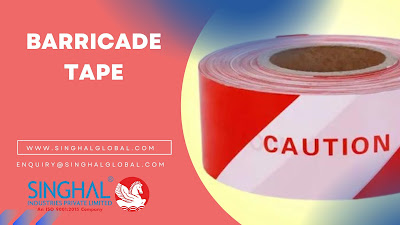In industries ranging from construction to law enforcement, warning tape plays a crucial role in alerting individuals to potential hazards and guiding them to safety. Whether it's Police Barricade Tape, Safety Warning Tape, or other variants, using them effectively requires attention to detail and adherence to best practices. In this guide, we'll explore essential tips for maximizing safety with warning tape, drawing insights from industry research and practical experience.
Understanding the Importance of Warning Tape
Safety Warning Tape serves as a visual cue, communicating vital information to workers, pedestrians, and the general public. From marking off dangerous areas to delineating traffic routes, its presence can prevent accidents and minimize risks in various settings. Manufacturer of Flexible Packaging Products like Singhal Industries produce high-quality warning tape designed to withstand harsh conditions and provide reliable signaling.
Selecting the Right Type of Warning Tape
Choosing the appropriate warning tape is paramount to its effectiveness. Police Barricade Tape, for instance, is specifically designed for law enforcement purposes and is highly visible even from a distance. Safety Warning Tape, on the other hand, may be used in construction sites or industrial settings to alert workers to potential hazards. Understanding the specific requirements of your environment is crucial in selecting the right type of tape for the job.
Ensuring Proper Installation
Proper installation of Safety Warning Tape is essential to ensure visibility and effectiveness. It should be securely fastened and positioned in a way that maximizes visibility from all angles. Additionally, regular inspections should be conducted to check for any signs of wear or damage that may compromise its functionality.
Incorporating Clear Messaging
Clear and concise messaging is key to the effectiveness of warning tape. Messages should be easily understood and convey specific instructions or warnings. Utilizing universally recognized symbols and colors can enhance comprehension and ensure that the message is communicated effectively to individuals of all backgrounds.
Implementing Ongoing Training and Education
Training and education are critical components of a comprehensive safety program involving warning tape. Employees should be educated on the importance of warning tape, its various applications, and proper usage techniques. Regular training sessions can reinforce safety protocols and promote a culture of awareness and accountability.
Conducting Regular Maintenance
Regular maintenance is essential to ensure the continued effectiveness of warning tape. This includes inspecting for signs of wear, tear, or fading, and replacing tape as needed. Additionally, environmental factors such as weather conditions and exposure to chemicals should be taken into account when assessing the longevity of warning tape.
Collaborating with Reputable Manufacturers
Partnering with reputable Warning Tape Manufacturers like Singhal Industries ensures access to high-quality products backed by rigorous testing and quality control measures. By leveraging the expertise of trusted manufacturers, businesses can enhance safety protocols and mitigate potential risks in their operations.
Conclusion
In conclusion, ensuring safety with warning tape requires a combination of careful planning, proper implementation, and ongoing maintenance. By following essential tips such as selecting the right type of tape, ensuring proper installation, incorporating clear messaging, and collaborating with reputable manufacturers, businesses can maximize the effectiveness of warning tape in mitigating risks and promoting a safe working environment. With safety being paramount in any industry, investing in robust safety measures, including the use of quality warning tape, is an investment in the well-being of employees and the community at large.
Frequently Asked Questions (FAQ)
1. What is warning tape used for?
Warning tape is used to alert individuals to potential hazards or dangers in various environments. It is commonly employed in construction sites, crime scenes, industrial facilities, and public events to mark off restricted areas, identify boundaries, and guide individuals away from danger zones.
2. What is danger tape called?
Danger tape is also commonly referred to as caution tape, safety tape, or hazard tape. Regardless of its name, its primary function remains the same: to warn individuals of potential dangers and restrict access to hazardous areas.
3. What color is warning tape?
Warning tape typically comes in bright, highly visible colors such as yellow, red, or orange. These colors are chosen for their ability to stand out against different backgrounds and to attract attention, ensuring that the warning message is clearly communicated to individuals in the vicinity.
4. How do you use caution tape?
Caution tape is used by stretching it across an area to create a visible barrier or boundary. It can be tied to posts, trees, or other structures, or simply placed on the ground to demarcate restricted areas. Proper installation and positioning of caution tape are essential to effectively communicate warnings and prevent unauthorized access to hazardous zones.
5. Why is caution tape important?
Caution tape plays a crucial role in promoting safety and preventing accidents in various settings. It serves as a visual indicator of potential hazards, guiding individuals away from danger and ensuring compliance with safety protocols. By alerting people to risks and restricting access to hazardous areas, caution tape helps minimize the likelihood of accidents, injuries, and property damage.


No comments:
Post a Comment